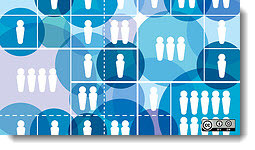Big Data and What You Can Do With It
The amount of data in our world has been exploding. Eric Schmidt at Google has stated: “Every 2 Days We Create As Much Information As We Did Up To 2003“. (Techcrunch).
Imagine the scope! And, analyzing large data sets, called Big Data, is becoming a large basis of use for businesses and their competitors alike. “Data” is important to every aspect of business. However, data is especially powerful to those seeking to leverage search, social, mobile, local, video, marketing and emerging technologies to compete, provide actionable intelligence to executive teams, provide better customer experiences and earn more market share.
Big Data is a term often associated with Fortune 500 and 1000 companies because these enterprises often have greater resources to invest into the collection and analysis of data. If you’re a social media “expert” and you don’t know the connection between Big Data and Social Media, then you should sit up and take notice.
Social Media by the Numbers – Twitter/Facebook
The popularity of social networking has dramatically increased in recent years. Today, there are more than 1.11 billion Facebook users and 500 million Twitter accounts. This growth has led to a rise in the amount of data created daily, with Facebook reporting 665 million active users each day. Moreover, with the increased interest in Big Data and the capabilities it provides, everyone is suddenly interested to discover exactly what it can do for their business.
With the growing prevalence of users to post an abundance of information about their everyday lives, it provides businesses an opportunity to monitor the data and identify patterns of behavior in individual users. However, due to the vast amount of data produced by social networks on a daily basis, the analysis of this information cannot be performed with a mere software algorithm; rather it must be done using Big Data analytics.
What is Big Data?
Big Data is a collection of both structured and unstructured data sets that are so immense, ranging from a few dozen terabytes to several petabytes. The data is beyond the ability of regular software tools to capture, manage, and process it within a reasonable period of time. Unstructured data, which constitutes around 90 percent of Big Data, is made up of emails, social media posts, tweets, videos, mobile phone calls, and website clicks. The Interwebs provides gargantuan user-generated content (UGC). Structured data makes up the remainder of Big Data and is information contained in databases.
Big Data Analytics is where businesses derive new meaning from new data sources. New, meaning that was never practical to discover before. This could be because of scale, data formats, the distribution of data in many locations, or the fact that no one thought of looking before – or how to make use of it in the first place. It is easily as much a new mindset as it is new technology. Executives and technologists are continuing the discussion, but real world applications are now put to use. Tableau Software provides analytics in the cloud right now.
Who are the Largest Players in Big Data?
A science team at a leading edge technology firm that leverages massive Twitter historical data and many other social media datastreams – @datasift – analyzed the social interaction around big data in 2012. The result was shown in the big data social media infographic. The top five big data related tweets were Apache, 10gen, IBM, HP and Teradata. And, when it comes to big data services and infrastructures, don’t miss The Big Data 100.
Businesses must care about Big Data so they can learn what to offer, to whom, when to offer something new, and what channels to use. It can also help them know if they can handle problems themselves or they need to get outside help, which competitor might be winning. Shareholders and upward moving company stock prices will reflect victories in this area. Big Data will be the one of the most important things for business since the Internet due to the business insights that it can provide. However, a small mom-and-pop business may not use at this massive scale, but can get social media analytics and reports from tools like Hootsuite today.
Big Data and Social Analytics
Historically, data analytics software hasn’t had the capability to take a large data set and use it to compile a complete analysis for a query. Instead, it has relied on representative samplings or subsets of the information to render results. That approach is changing with the emergence of new Big Data analytics engines, such as the opensource Apache Hadoop.
Hadoop processes large caches of data by breaking them into smaller, more accessible batches and distributing them to multiple servers to analyze. Hadoop then processes queries and delivers the requested results in far quicker than old‐school analytics software—most often minutes instead of hours or days. Hadoop and other such systems provide complete looks at big data sets, instead of a team of analysts spending days or weeks preparing the parameters for data subsets and percent samplings.
So with this overload of data, you must understand how it can be analyzed. Keep in mind the difference between just “data” and the “right data” – data that drives actions. With social media, it can be confusing as to which data is “right,” but again, focus on data that drives actions – either a change in business processes or a change in behaviors. The key to fostering the growth of social media and Big Data is understanding how to make each work individually – one to generate the “right data,” and the other to process and analyze the data.
By using specific social media monitoring platforms such as Radian6 and Buddy Media, you are half way there and can take this data and use the specific results to drive campaigns. You can appeal to the masses by tracking trends, addressing consumer concerns through their feedback, and identifying key influencers who can become brand advocates. These are all excellent ways of using the power of big social media data analysis. Big data analytics platforms like Paraccel may be considered for larger enterprises.
Experience the Power of Data
If you’re actively working on any digital aspect of a brand without the benefit of data, you’re just wasting your time. In this digital age, it is essential to identify trends and opportunities. Now, more than ever, data will play a vital role in every aspect of business. Data always has been a goldmine for marketers (strategy, social, search, SEO, PPC, PR).
However, it’s safe to say that the anticipated growth of data and emerging use of unstructured data are game-changers. Working with Big Data and Social Media will only lead to greater success as technology continues to advance. Those who recognize and embrace the power of this mountain of data early on are most likely reap the most rewards.
You can learn more about digital analytics and big data from our analytics primer.
Jon Rognerud and Chaosmap work with Fortune 500 companies, associations and entrepreneurs to create digital traffic strategies that scale up members, customers, leads and sales with profitable returns. Mr. Rognerud wrote a best-selling book (Buy On Amazon), “The Ultimate Guide To Optimizing Your Website” (Entrepreneur). Connect directly here.









